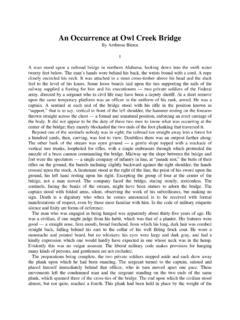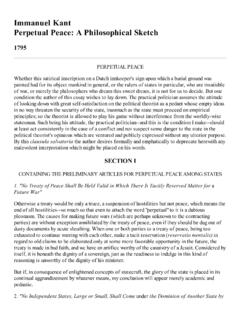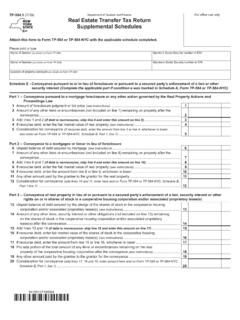Transcription of THE HEALTH WORKFORCE IN INDIA - World Health …
1 THE HEALTH WORKFORCE IN INDIA Human Resources for HEALTH Observer Series No. 16 Sudhir Anand and Victoria Fan THE HEALTH WORKFORCE IN INDIA Human Resources for HEALTH Observer Series No. 16 Sudhir Anand and Victoria Fan WHO Library Cataloguing-in-Publication DataThe HEALTH WORKFORCE in HEALTH 978 92 4 151052 3 Subject headings are available from WHO institutional repository World HEALTH organization 2016 All rights reserved. Publications of the World HEALTH organization are available on the WHO website ( ) or can be purchased from WHO Press, World HEALTH organization , 20 Avenue Appia, 1211 Geneva 27, Switzerland (tel.: +41 22 791 3264; fax: +41 22 791 4857; email: Requests for permission to reproduce or translate WHO publications whether for sale or for non-commercial distribution should be addressed to WHO Press through the WHO website ( ).)
2 The designations employed and the presentation of the material in this publication do not imply the expression of any opinion whatsoever on the part of the World HEALTH organization concerning the legal status of any country, territory, city or area or of its authorities, or concerning the delimitation of its frontiers or mention of specific companies or of certain manufacturers products does not imply that they are endorsed or recommended by the World HEALTH organization in preference to others of a similar nature that are not mentioned. Errors and omissions excepted, the names of proprietary products are distinguished by initial capital reasonable precautions have been taken by the World HEALTH organization to verify the information contained in this publication. However, the published material is being distributed without warranty of any kind, either expressed or implied.
3 The responsibility for the interpretation and use of the material lies with the reader. In no event shall the World HEALTH organization be liable for damages arising from its by by L IV Com S rl, Villars-sous-Yens, by the WHO Document Production Services, Geneva, No. 16 TABLE OF CONTENTSF oreword ..5 Preface ..6 Acknowledgements ..8 Summary of findings ..9 National profile ..9 Interstate comparisons ..9 Interdistrict differentials in INDIA ..101. Introduction ..122. National profile .. Interdistrict inequalities .. Urban rural distribution .. Male female distribution .. Education level and medical qualification .. Main and marginal HEALTH workers ..253. Interstate comparisons .. Concentration of HEALTH workers .. Composition of HEALTH workers .. HEALTH worker densities by education, stratum and gender.
4 HEALTH worker distribution by gender, education and stratum .. Interdistrict differentials within states ..544. Interdistrict differentials in INDIA .. All HEALTH workers .. Allopathic doctors .. Nurses and midwives .. Other HEALTH worker categories: pharmacists, AYUSH doctors and dentists ..855. Concluding remarks ..95 Annex 1. Description of NCO four-digit codes ..97 Annex 2. List of medical qualifications ..98 The HEALTH WORKFORCE in INDIA 2 TablesTable 1. HEALTH worker categories with corresponding NCO codesTable HEALTH WORKFORCE in INDIA , 2001 Table HEALTH workers by urban rural stratum and genderTable HEALTH workers by education level and by medical qualificationTable Composition of HEALTH workers with more than secondary schooling and with a medical qualification by category: disaggregated by stratum and gender Table Percentage of HEALTH workers with more than secondary schooling and percentage with a medical qualification, by stratum and genderTable Main and marginal HEALTH workers: summary statisticsTable Concentration by state of HEALTH workers (% in state as fraction of national total)Table Selected categories of HEALTH workers by education levels (A), (B) and (C).
5 Concentration by stateTable Composition of all HEALTH workers, and composition of all doctors, in each stateTable Density of HEALTH workers per lakh population, by stateTable Density of HEALTH workers with more than secondary schooling, by stateTable Density of HEALTH workers with a medical qualification, by stateTable Ratio of urban density to rural density of HEALTH workers, by stateTable Percentage of HEALTH workers who are female, by stateTable Percentage of HEALTH workers with more than secondary schooling, by stateTable Percentage of HEALTH workers with a medical qualification, by stateTable All HEALTH workers by education levels (A), (B) and (C): interdistrict differentials, by stateTable Allopathic doctors by education levels (A), (B) and (C): interdistrict differentials, by stateTable Nurses and midwives by education levels (A), (B) and (C): interdistrict differentials, by stateTable Pharmacists by education levels (A), (B) and (C): interdistrict differentials, by stateTable AYUSH doctors by education levels (A), (B) and (C): interdistrict differentials, by stateTable Dental practitioners by education levels (A), (B) and (C): interdistrict differentials, by stateTable (A).
6 All HEALTH workers with any level of education: ranking of districts by density lowest 30 and highest 30 districtsTable (B). All HEALTH workers with more than secondary schooling: ranking of districts by density lowest 30 and highest 30 districtsTable (A). Allopathic doctors with any level of education: ranking of districts by density lowest 30 and highest 30 districtsTable (B). Allopathic doctors with more than secondary schooling: ranking of districts by density lowest 30 and highest 30 districtsTable (C). Allopathic doctors with a medical qualification: ranking of districts by density lowest 30 and highest 30 districts3 Series No. 16 Table (A). Nurses and midwives with any level of education: ranking of districts by density lowest 30 and highest 30 districtsTable (B). Nurses and midwives with more than secondary schooling: ranking of districts by density lowest 30 and highest 30 districtsTable (C).
7 Nurses and midwives with a medical qualification: ranking of districts by density lowest 73 and highest 17 districtsTable (A). Pharmacists with any level of education: ranking of districts by density lowest 30 and highest 30 districtsTable (B). Pharmacists with more than secondary schooling: ranking of districts by density lowest 30 and highest 30 districtsTable (A). AYUSH doctors with any level of education: ranking of districts by density lowest 30 and highest 30 districtsTable (B). AYUSH doctors with more than secondary schooling: ranking of districts by density lowest 30 and highest 30 districtsTable (C). AYUSH doctors with a medical qualification: ranking of districts by density lowest 32 and highest 28 districtsTable (A). Dental practitioners with any level of education: ranking of districts by density lowest 60 and highest 30 districtsTable (B).
8 Dental practitioners with more than secondary schooling: ranking of districts by density lowest 88 and highest 2 districtsTable (C). Dental practitioners with a medical qualification: ranking of districts by density lowest 175 and highest 5 districtsTable 4. Number of common districts among lowest 30, and among highest 30, districts ranked by HEALTH worker density in distributions (A), (B) and (C) Figures Figure HEALTH workers by category: absolute numberFigure HEALTH workers by category: interdistrict GiniFigure HEALTH workers by category: absolute number by urban rural stratumFigure HEALTH workers by category: ratio of urban density to rural density, and male female ratioFigure HEALTH workers by category: absolute number by genderFigure HEALTH workers by category: disaggregated by level of educationFigure Percentage of HEALTH workers with more than secondary schooling, by stratum and genderFigure Percentage of HEALTH workers with a medical qualification, by stratum and genderFigure Allopathic doctors, population, and nurses and midwives.
9 Concentration by stateFigure Allopathic doctors by education levels (A), (B) and (C): concentration by stateFigure Percentage of nurses vs percentage of doctors, by stateThe HEALTH WORKFORCE in INDIA 4 Figure Doctor nurse ratio and doctor density, by stateFigure Allopathic doctors and nurses and midwives: density by stateFigure Allopathic doctors and nurses and midwives: ratio of urban density to rural density, by stateFigure Allopathic doctors and nurses and midwives: percentage who are female, by stateFigure Allopathic doctors and nurses and midwives: percentage with more than secondary schooling, by stateFigure Allopathic doctors and nurses and midwives: percentage with a medical qualification, by stateFigure All HEALTH workers by education levels (A), (B) and (C): interdistrict Gini, by stateFigure Allopathic doctors by education levels (A), (B) and (C): interdistrict Gini, by stateFigure Nurses and midwives by education levels (A), (B) and (C): interdistrict Gini, by stateFigure Pharmacists by education levels (A), (B) and (C): interdistrict Gini, by stateFigure AYUSH doctors by education levels (A), (B) and (C): interdistrict Gini, by stateFigure Dental practitioners by education levels (A), (B) and (C): interdistrict Gini, by stateFigure District density of all HEALTH workers: histogram (593 bins) and Epanechnikov kernel estimateFigure District density of all HEALTH workers: alternative kernel estimatesFigure District density of allopathic doctors.
10 Histogram (593 bins) and Epanechnikov kernel estimateFigure District density of allopathic doctors by education levels (A), (B) and (C): Epanechnikov kernel estimatesFigure District density of nurses and midwives: histogram (593 bins) and Epanechnikov kernel estimate 5 Series No. 16In September 2015, the World came together to launch an ambitious Agenda for Sustainable Development. People, planet, peace, prosperity, and partnership are prioritized, with a commitment to leave no one behind. Evidence-based HEALTH WORKFORCE plans and policies carry with them the potential to deliver benefits across the Sustainable Development Goals: improving HEALTH , creating employment, and generating inclusive economic growth, particularly for women and youth. Complementing the more traditional supply-side perspective of an available, accessible, acceptable and quality HEALTH WORKFORCE is the more recent recognition of a demand-side perspective that relies on HEALTH labour markets to understand the formation, employment, deployment, remuneration and distribution of the HEALTH WORKFORCE .


















